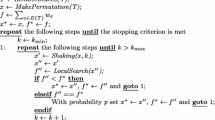Abstract
The solution of the Subproblem of the Cutting Angle Method of Global Optimization for problems of minimizing increasing positively homogeneous of degree one functions is proved to be NP-Complete. For the proof of this fact we formulate another problem which we call “Dominating Subset with Minimal Weight”. This problem is also NP-Complete. An O(n2)-time algorithm is presented for approximate solution of Dominant Subset with Minimal Weight Problem. This problem can be expressed as a kind of Assignment Problem in which it is allowed to assign multiple tasks to a single processor. Experimental analysis of the algorithm is performed using the program implemented in ANSI-C. The results of the analysis show the efficiency of the proposed algorithm.
Similar content being viewed by others
References
Andramonov, M.Yu., Rubinov, A.M. and Glover B.M. (1997), Cutting Angle methods for minimizing increasing convex along rays functions. Research Report 97/7, SITMS, University of Ballarat.
M.Yu. Andramonov A.M. Rubinov B.M. Glover (1999) ArticleTitleCutting Angle methods in Global Optimization Applied Mathematics Letters 12 95–100 Occurrence Handle10.1016/S0893-9659(98)00179-7
Babayev, Dj.A. (2000), An exact method for solving the subproblem of the cutting angle method of global optimization. In: Optimization and Related Topics, in Kluwer Academic Publishers, ser. ‘Applied Optimization’, Dordrecht, Vol. 47, pp. 15–26.
A.M. Bagirov A.M. Rubinov (2000) ArticleTitleGlobal minimization of increasing positively homogeneous functions over the unit simplex Annals of Operation Research 98 171–187 Occurrence Handle10.1023/A:1019204407420
A.M. Bagirov A.M. Rubinov (2001) Modified versions of the cutting angle method N. Hadjisavvas P.M. Pardalos (Eds) Nonconvex Optimization and Its Applications Advances in Convex Analysis and Global Optimization Kluwer Academic Publishers Dordrecht
A.M. Bagirov A.M. Rubinov (2003) ArticleTitleCutting angle method and a local search Journal of Global Optimization 27 193–213 Occurrence Handle10.1023/A:1024858200805
R.M. Garey D.S. Johnson (1979) Computers and Intractability: A Guide to the Theory of NP-Completeness W.H. Freeman and Company New York NY
R. Horst P.M. Pardalos N.V. Thoai (2000) Introduction to Global Optimization, Nonconvex Optimization and its Applications Kluwer Academic Publishers Dordrecht
S. Martello P. Toth (1990) Knapsack Problems: Algorithms and Computer Implementations John Wiley and Sons Chichester
A.M. Rubinov (2000) Abstract Convexity and Global Optimization Kluwer Academic Publishers Dordrecht
A.M. Rubinov M.Yu. Andramonov (1999) ArticleTitleMinimizing increasing star-shaped functions based on abstract convexity Journal of Global Optimization 15 19–39 Occurrence Handle10.1023/A:1008344317743
A.M. Rubinov M. Yu. Andramonov (1999) ArticleTitleLipshitz programming via increasing convex along rays functions Optimization Methods and Software 10 763–781
Author information
Authors and Affiliations
Corresponding author
Additional information
Mathematics Subject Classification (2000): 65K05, 90C27, 68Q25
Rights and permissions
About this article
Cite this article
Nuriyev, U.G. An Approach to the Subproblem of the Cutting Angle Method of Global Optimization. J Glob Optim 31, 353–370 (2005). https://doi.org/10.1007/s10898-004-1687-x
Received:
Accepted:
Issue Date:
DOI: https://doi.org/10.1007/s10898-004-1687-x




